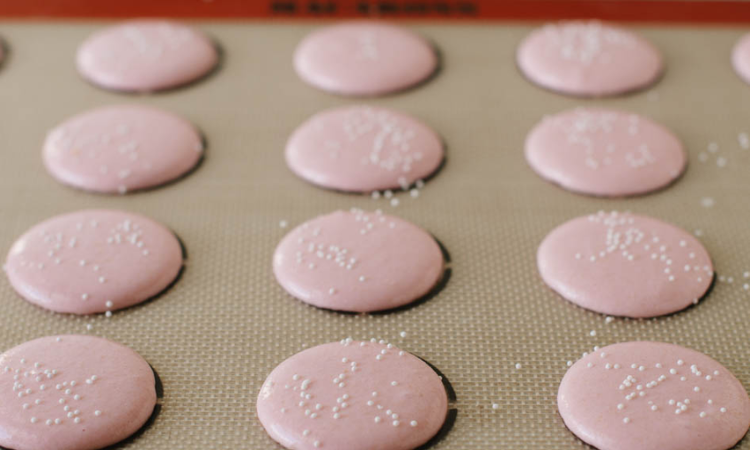What Is the Ideal Baking Temperature for Macarons?: The secret to making perfect macarons is to bake them at just the proper temperature. Macaron baking is an art form that calls for precision. The texture, color, and overall quality of these delightful treats can be drastically improved by maintaining the ideal temperature. This tutorial will help you become a better baker by delving into the nuances of macaron baking temperatures.
Understanding the Basics
Before we get into the ideal temperature, let’s review the basics. Meringue is the key ingredient of macarons, which are delicate cookies with a chewy interior and a crisp exterior. In order to get the perfect texture balance, the right temperature must be maintained throughout the baking process.
The Goldilocks Zone: Not Too Hot, Not Too Cold
The process of making macarons is analogous to the search for the Goldilocks zone when it is neither too hot nor too cold. Temperatures between 149 and 163 degrees Celsius (or 300 and 325 Fahrenheit) are considered ideal. The macarons can rise and set adequately within this temperature range without browning too soon.
Factors Influencing Temperature
Humidity Matters
High humidity could ruin your macaroons. It may be necessary to lower the oven temperature slightly during humid weather to compensate for the additional moisture in the air.
Oven Discrepancies
Since each oven is unique, learning how yours operates is essential. Get a thermometer for your oven before making any adjustments.
Myth Busted: What’s So Bad About Being Slow?
It is widely held that macarons fare better when baked at a lower temperature for a longer amount of time. However, this is not always the case. Lowering the temperature can reduce browning, but it can also result in empty or undercooked macarons.
Perplexity in Baking: Finding the Sweet Spot
They are confused if they hear that baking is complex and detailed. The key to perfectly baked macarons is discovering the “sweet spot,” the temperature at which the exterior is crisp, the interior is chewy, and the feet are well-formed.
Point-to-Point Tips for Baking Success
Start Heating the Oven.
It is imperative that the oven be preheated at the correct temperature before baking the macarons. This ensures instantaneous temperature parity.
Get a Baking Sheet
The use of a silicone baking surface will ensure that the macarons bake evenly and will prevent them from sticking to the pan.
Rotate the Trays
Turn the trays halfway through baking for more even cooking. This will help reduce the temperature differentials inside your oven.
Check for Doneness
Keep a close eye on the macarons as the baking time nears its end. They should be able to be lifted off the mat without difficulty or sticking.
Allow for Cooling
Wait until the macarons have cooled completely on the tray after they have finished baking. This prevents the texture from changing or breaking down in any way.

The Importance of Temperature Consistency
Consistency and maintaining a steady temperature are both crucial when baking macarons. Macarons that are baked at different temperatures will have different textures and appearances. Calibrate your oven and keep an eye out for temperature fluctuations while you’re baking.
Presence Penalties: Avoiding Pitfalls
Macaron makers beware of presence penalties, which might adversely affect the final product. To avoid such fines, keep in mind the following:
Avoid Opening the Oven Door Frequently
When the oven door is opened, heat is released and baking is halted. Try not to disturb the macarons too frequently so that the temperature can remain stable.
Recognize the Ingredients at Room Temperature
For a smooth batter, the components must be at room temperature. Macarons’ texture could be negatively influenced if cold ingredients are used.
Test Your Oven’s Accuracy Regularly
Variations in oven temperatures can occur over time. If you want to be sure your oven is accurate, you should use a different thermometer on a regular basis.
Conclusion
Finding the optimal baking temperature is crucial for macarons. Accepting the complexities of the method, debunking fallacies, and learning the basics will give you the assurance you need to bake macarons that stand out. Remember that making perfect macarons requires not only sticking to the recipe but also finding the right balance.
Frequently Asked Questions
Can I use a Convection Oven to Cook Macarons?
A: You can use a convection oven, but you should watch out for temperature swings and pay particular attention to the baking process.
Why are there Holes in the Middle of my Macarons?
A: Hollow macarons might result from overmixing the batter or baking at a low temperature. Take precise readings and stay within the recommended temperature range.
What Happens if My Silicone Baking Mat is Missing?
Although parchment paper can be used instead of a silicone mat, the latter has the advantage of reducing sticking and providing better heat dispersion.
Can I Bake Macarons of Varying Flavors at the Same Temperature?
Although the temperature range remains the same, slight adjustments may be required for ingredients like cocoa powder or food coloring.
Can I Check on the Macarons while they are baking by opening the oven?
Avoid opening the oven door unless absolutely necessary; doing so might cause significant temperature fluctuations. Instead, use the oven light as a progress indicator.
I hope you like the part where we talked about What Is the Ideal Baking Temperature for Macarons? in detail. Visit our site, Food Marvel.

